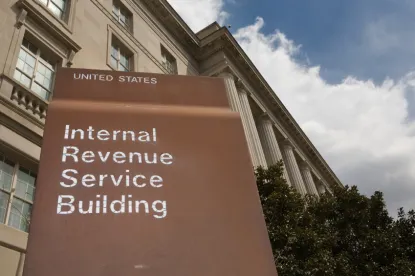The IRS has issued Notice 2014-19 and a set of Answers to Frequently Asked Questions (“FAQs”), providing new guidance to sponsors and administrators of qualified retirement plans on the treatment of same-sex couples following the Supreme Court’s decision in United States v. Windsor, No. 12-307 (June 26, 2013).
Previous IRS guidance, Revenue Ruling 2013-17 and a related set of Answers to Frequently Asked Questions, announced that same-sex couples who are legally married in jurisdictions recognizing their marriages will be treated as married for all federal tax purposes regardless of whether the couple currently lives in a jurisdiction that recognizes same-sex marriage, but left many questions unanswered. (For details on Revenue Ruling 2013-17, please see IRS Rules All Legal Same-Sex Marriages Will Be Recognized for Federal Tax Purposes.) Notice 2014-19 and the accompanying FAQs provide much-needed direction on complying with the various applicable Internal Revenue Code provisions impacted by Windsor and Revenue Ruling 2013-17.
Affected Retirement Plan Provisions
Windsor and Revenue Ruling 2013-17 affect a number of provisions applicable to qualified retirement plans, including:
-
Qualified joint and survivor annuity (“QJSA”) and qualified preretirement survivor annuity (“QPSA”) rules under Internal Revenue Code (“Code”) Section 401(a)(11), QJSA/QPSA waiver rules under Code Section 417, and the exception from the QJSA/QPSA requirements for certain defined contribution retirement plans under Code Section 401(a)(11)(B)(iii).
-
Special provisions applicable to surviving spouses in the required minimum distribution rules under Code Section 401(a)(9) and rollover rules under Code Section 402(c).
-
Constructive ownership rules applicable to spouses under Code Section 1563(e)(5) (for purposes of controlled group affiliation, including analyses under Code Sections 414(b),(c) and (m)) and Code Section 318(a)(1) (for purposes of determining key employee status).
-
Restrictions on allocations of employer securities under an employee stock ownership plan (“ESOP”) to certain spouses under Code Sections 409(n) and (p).
-
Exception to the anti-alienation rule for qualified domestic relations orders (“QDROs”) under Code Section 401(a)(13)(B) and treatment of a spouse or former spouse alternate payee as the distributee of a QDRO distribution under Code Section 402(e)(1).
IRS Notice 2014-19 and New FAQs: What Qualified Retirement Plan Sponsors Need to Do Now
Ensure That Plan Operations Conform to Requirements
-
Prior to June 26, 2013, a qualified retirement plan was not required to recognize same-sex spouses. IRS Notice 2014-19, Q&A-3, provides that plan sponsors may choose to recognize same-sex spouses retroactively prior to this date, for some or all plan purposes. However, such plan sponsors must be cautious of causing unintended plan operational and qualifications issues (for example, see “Caution for Sponsors of Defined Benefit Plans,” below).
-
Effective as of June 26, 2013, pursuant to Windsor, qualified retirement plans are required to recognize legally-married same-sex couples. For example, a plan subject to QJSA/QPSA requirements must recognize a lawfully married same-sex spouse of a participant who dies on or after June 26, 2013, regardless of any conflicting beneficiary designation (unless the same-sex spouse provided full spousal consent to such designation). However, prior to September 15, 2013, plans need not recognize the same-sex spouse of a participant domiciled in a state that does not recognize same-sex marriage (in practice, we have not encountered any plans that made this distinction, which would have been administratively impractical and costly).
-
Effective as of September 16, 2013, pursuant to Revenue Ruling 2013-17, qualified retirement plans are required to extend recognition to all legally married same-sex spouses, even if they are domiciled in a state that does not recognize same-sex marriages.
-
If the retroactive effect of Windsor and Revenue Ruling 2013-17, as interpreted by Notice 2014-19, causes a plan operational error, FAQ-3 provides that such error may be corrected using principles similar to those set forth in Revenue Procedure 2013-12, the Employee Plans Compliance Resolution System (“EPCRS”). For example, a plan may need to obtain new spousal consents from same-sex spouses to remedy a failure to obtain their consents after June 26, 2013.
Determine whether a Plan Amendment is Required or Warranted
-
A qualified retirement plan amendment is required if plan terms are inconsistent with Windsor or Revenue Ruling 2013-17, as interpreted by Notice 2014-19. For example, a plan must be amended if it defines “spouse” by reference to section 3 of DOMA, or only as a person of the opposite sex.
-
A plan amendment is also required if the plan sponsor elects to apply Windsor for some or all purposes as of a date prior to June 26, 2013. Such an amendment must specify the effective date and purposes for which Windsor is applied prior to June 26, 2013.
-
If plan terms are not inconsistent with Windsor and Revenue Ruling 2013-17, as interpreted by Notice 2014-19 (for example, where the terms “spouse,” “legally married spouse” or “spouse under Federal law” are used in the plan without distinction between a same-sex spouse and an opposite-sex spouse), and the plan sponsor does not recognize same-sex spouses prior to June 26, 2013 for any purpose, then a plan amendment is not required. However, as a matter of best practices, we recommend that plan sponsors adopt a clarifying amendment in all cases, to document compliant operations and expressly define the term “spouse” (or its equivalent) in a manner consistent with Windsor and Revenue Ruling 2013-17.
-
Additionally, FAQ-4 permits a plan amendment providing certain special rights or benefits to participants with same-sex spouses to make up for benefits not previously available to those participants, such as a new opportunity to elect a distribution in the form of a qualified joint and survivor annuity. We caution plan sponsors adopting such an amendment to speak with counsel in order to avoid causing inadvertent operational errors or violating other applicable plan qualification requirements, including the nondiscrimination provisions under Code Section 401(a)(4).
-
If a plan amendment is required, it must be adopted by the later of December 31, 2014, or the applicable date under Revenue Procedure 2007-44 (special amendment deadlines apply to governmental and Code Section 403(b) plans). Therefore, single-employer calendar year plans, that are not governmental or Code Section 403(b) plans, will generally need to adopt the amendment on or before December 31, 2014.
Caution for Sponsors of Defined Benefit Plans
Certain single-employer defined benefit plans are subject to funding-based restrictions under Code Section 436, including limitations on amendments that increase plan liabilities under Code Section 436(c). IRS Notice 2014-19, Q&A-9, provides that a plan amendment that is required to conform plan terms to Windsorand Revenue Ruling 2013-17 and takes effect on June 26, 2013, is exempt from the Code Section 436(c) restrictions. However, a plan amendment providing for the application of Windsor prior to June 26, 2013 is not exempt from the restrictions. Such an amendment may require a plan funding contribution to offset the added plan liabilities and, if the contribution is not timely made, cause plan disqualification.





 />i
/>i

